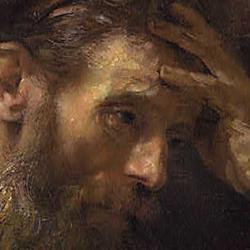As many commentators have suggested (Douglas Moo most clearly), there is an inclusio around Romans 5-8 that shows it is a distinct unit. Below are some of the key words shared between 5:1-11 and 8:14-39, with some comments:
1) DIKAIOO: “justify”: 5:1, 9; 6:7; 8:30, 33: This verb, prominent in Rom 1-4, is used only a handful of times in this passage. Strikingly, the one time it is used between 5:9 and 8:30 is in 6:7, where it is used in an apparently unusual sense of “justified from sin.”
2) ELPIS: “hope” (n); ELPIZO: “hope” (v): 5:2, 4, 5; 8:20, 24-25. Though hope has been introduced in Paul’s discussion of Abraham (4:18) as a constitutive aspect of faith, this theme comes into its own in this section. Paul moves from justification to hope in 5:1-2, and the whole section concludes on this note as well. I agree with those commentators who see “hope” as one of the key themes of this whole section. Also, it should be noted that it is hope for glory, which means hope for the restoration and enhancement of Adamic humanity; and it is a hope for a renewed creation, for the inheritance of the “world” that was promised to Abraham.
3) AGAPE: “love”: 5:5, 8; 8:35, 39. The verb form is used in 8:28, 37. Rom 5:5 is the first use of the word in Romans, and it is not used between 5:8 and 8:28. Hope and love are clearly linked as well, as when Paul grounds the certainty of our hope in the fact that God’s love is poured out through the Spirit (5:5).
4) ASTHENTOS/ASTHENEIA: “weak” and “weakness”: 5:6; 8:26.
5) THLIPSIS: “tribulation”: 5:3; 8:35. The only other uses in Romans are at 2:9 and 12:12. The connection between “hope” and “tribulation” is obvious; in the midst of trials we are to hope for ultimate rescue. The link of tribulation and justification is less obvious, but no less important in the biblical picture. Noah, the first man described as “righteous” in the sight of God, is designated as such when the world is heading toward decreation. To be “righteous” includes being picked out for ultimate rescue in tribulation. And not just rescue: Noah has hope that he will inherit the new world that God will construct on the other side of the decreation. Those who are counted righteous thus have hope for rescue in tribulation, and hope for inheriting a new creation. The pattern is the same in Paul. For Paul, justification is never the end of the story; justification is the beginning of a story of perseverance and deliverance, a story of new creation and inheritance.
6) HUPOMONE: “patience”: 5:3-4; 8:25. Again, the link with tribulation is self-evident, and also the link with hope.
7) SOZO: “save”: 5:9-10; 8:24. Between these two occurrences, the word is not used at all. In both cases, salvation is a future reality, for which we hope.
Given these signs of inclusio, it seems reasonable to suspect a chiastic structure here. Moo finds a chiasm, but it’s fairly clunky. A slightly less clunky and very preliminary chiasm might be:
A. 5:1-11: The justified have hope for glory in midst of tribulation, because of God’s love
B. 5:12-21: Adam and Christ: Adam’s sin reversed
C. 6:1-14: Death in baptism means deliverance from dominance of sin
D. 6:15-23: Members are to be presented as weapons of righteousness
E. 7:1-6: Death to the law through the death of our Husband
D’. 7:7-25: Bondage to sin provoked by law; a different law warring in members
C’. 8:1-17: God delivered where Law could not, setting free from sin and death
B’. 8:18-25: Creation will be liberated from futility to which Adam subjected it
A’. 8:26-39: Assurance of hope in the midst of tribulation; we will not be separated from God’s love in Christ














